In this month’s alert
Editorial – September 2015
Welcome to the September edition of Alcohol Alert, the Institute of Alcohol Studies newsletter, covering the latest updates on UK alcohol policy matters.
In this issue, health and trade experts debate the meaning behind Advocate General Yves Bot’s opinion over the current minimum unit pricing court case. Other articles include: IAS respond to Institute of Economic Affairs release on the cost of alcohol misuse; new datasets from Scotland and Northern Ireland expose gap between drinking habits and health effects of high and low income earners.
Please click on the article titles to read them. We hope you enjoy this edition.
Minimum Unit Pricing legal if justified as best health measure
Both health and trade experts read positive signals from Judge Yves Bot’s opinion on the legal case
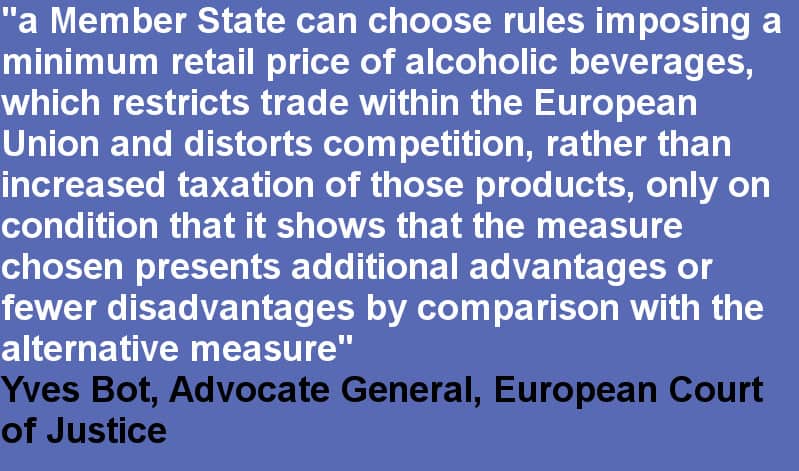 Public health experts are optimistic that the latest legal opinion on the long-running court case over a minimum unit price for alcohol (MUP) may pave the way for Scotland to introduce the law.
Public health experts are optimistic that the latest legal opinion on the long-running court case over a minimum unit price for alcohol (MUP) may pave the way for Scotland to introduce the law.
European Court of Justice (ECJ) Advocate General (AG) Yves Bot’s statement concluded that MUP does not contravene European law, provided it meets the objective of protecting public health.
His recommendations support the Scottish Government’s intention to fully implement the Alcohol (Minimum Pricing) (Scotland) Act – passed over three years ago – in order to tackle the health harms that the country faces from alcohol misuse.
The Advocate General’s conclusion states:
- That the Common Agricultural Policy does not preclude national rules which prescribe a minimum retail price for wines according to the quantity of alcohol in the product sold, provided that those rules are justified by the objectives of the protection of human health, and in particular the objective of combating alcohol abuse, and do not go beyond what is necessary in order to achieve that objective.
- That it is for the national court to decide whether the means chosen are appropriate for the attainment of the objective pursued and that, in making that choice, the Member State did not exceed its discretion, and that it has taken into account the extent to which that measure impedes the free movement of goods when it is compared with alternative measures that would enable the same objective to be attained and when all the interests involved are weighed up.
Coverage: A question of interpretation
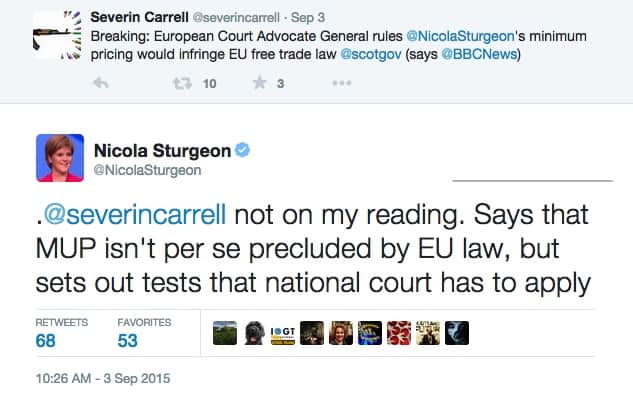 A wide range of stakeholders welcomed Yves Bot’s opinion, including Scotland’s First Minister, Nicola Sturgeon, who saw the judge’s statement as further affirmation of her Government’s cause (illustrated). She said: “The Advocate General confirms that minimum unit pricing is not precluded by EU law, but sets out tests that the national court has to apply.”
A wide range of stakeholders welcomed Yves Bot’s opinion, including Scotland’s First Minister, Nicola Sturgeon, who saw the judge’s statement as further affirmation of her Government’s cause (illustrated). She said: “The Advocate General confirms that minimum unit pricing is not precluded by EU law, but sets out tests that the national court has to apply.”
NHS Health Scotland saw the opinion as positive for the MUP case too. Dr Andrew Fraser, Director of Public Health Science, said: “A minimum unit price for alcohol could save hundreds of lives each year. No other pricing mechanism exists to achieve the same public health benefit, a key factor that will be taken into account by the European Court of Justice before delivering its final judgment”.
Ireland’s Ministry of Health took the same line, pointing out that minimum unit pricing may be compatible with EU law if it can be shown to be more effective than other alternative measures. Ireland plans to introduce MUP in its Public Health (Alcohol) Bill.
Mainstream media outlets adopted a more negative tone at first, influenced in part by comments from industry representatives leading the case against the Scottish Government, namely the Scotch Whisky Association (SWA) and SpiritsEUROPE.
David Frost, SWA chief executive, said: “The opinion encourages us in our long-held view that MUP is illegal when there are less trade restrictive measures available”. Paul Skehan, SpiritsEUROPE director general, added: “We welcome the Advocate General’s opinion. The opinion encourages us in our long-held view that MUP is neither proportionate nor necessary, and is, consequently, illegal under EU law”.
BBC Scotland announced that MUP was in conflict with EU trade rules, a message that was repeated across several media outlets, including The Telegraph and The Financial Times. But this was countered by the reactions of organisations more aware of the nuances of the Judge Bot’s statement.
Scottish Health Action on Alcohol Problems (SHAAP) has actively supported the Scottish Government in their effort of implementation the policy. SHAAP has also worked with its European and national partners on providing information about MUP. SHAAP Chair Dr. Peter Rice saw encouraging signs in the AG’s statement.
“As clinicians, we welcome the Advocate General’s opinion as a step towards implementing Minimum Unit Pricing as soon as possible. We are confident that Minimum Unit Price has substantial health improvement advantages over other possible price mechanisms and is therefore legal,” he said.
Other public health organisations, including the Alcohol Health Alliance, Alcohol Focus Scotland, UK Faculty of Public Health, and the European Alcohol Policy Alliance echoed SHAAP’s sentiment.
Commenting on the Advocate General’s opinion, Katherine Brown, Director of the Institute of Alcohol Studies said: “This brings us one step closer to a victory for public health. It can be quite clearly demonstrated that taxation alone cannot achieve the same effect as minimum unit pricing, partly because the EU tax rules prohibit member states from taxing all alcoholic drinks by strength.
“The Scottish Government acknowledged that minimum pricing was the best way they could target the cheapest alcohol that causes the most harm to individuals, families and communities. It is disgraceful that multinational alcohol producers were able to block a government from introducing a policy intended to save lives. However we are confident that in the end public health will triumph over big business in this case.”
Bot’s opinion will weigh heavily on the final decision of the ECJ judges, who are expected to take up to six months to issue their final ruling before the case is referred back to the Court of Session in Edinburgh.
Minimum Unit Pricing: The Advocate General’s view
By Jonathan Goodliffe, solicitor
In 2012 the Scottish Parliament passed a statute providing for the application of a minimum unit price (MUP) to alcohol. This was part of the Scottish government’s policy on reducing alcohol-related harm. The statute was challenged by parts of the drinks industry and by the European Commission. The challenge was heard in the Outer House of the Scottish Court of Session by the judge, Lord Doherty. Doherty rejected the challenge, but the industry appealed to the Inner House, who did not share Lord Doherty’s confident approach and made a reference to the Court of Justice of the European Union (CJEU).
For more background see my October 2014 article on this case.
The Advocate General’s opinion
 Advocate General (AG) Yves Bot (pictured) has now released his opinion on the merits of this case. He is a distinguished French lawyer. AGs are common in the higher courts of continental countries. In more important cases in the CJEU the advocate general sits with the judges and issues his or her opinion on the merits of the case at the conclusion of lawyers’ arguments. In the great majority of cases the Court follows the views of the AG. However in a not insignificant number of cases it does not.
Advocate General (AG) Yves Bot (pictured) has now released his opinion on the merits of this case. He is a distinguished French lawyer. AGs are common in the higher courts of continental countries. In more important cases in the CJEU the advocate general sits with the judges and issues his or her opinion on the merits of the case at the conclusion of lawyers’ arguments. In the great majority of cases the Court follows the views of the AG. However in a not insignificant number of cases it does not.
Bot’s opinion considers the questions referred to the CJEU by the Inner House of the Court of Session. Scotland’s case was supported by the United Kingdom as a whole and by some mainly wine consuming countries. It was opposed by other mainly wine producing countries.
The CMO regulation
The first issue concerned a European Union regulation establishing a common organisation of the markets (CMO) in agricultural products. It was argued that the Scottish minimum pricing regime was incompatible with the CMO. Bot agreed with this proposition but considered that the CMO did not preclude MUP, provided that MUP was justified by the objective of the protection of human health and in particular the objective of combating alcohol abuse. In addition MUP should not, in his view, go beyond what was necessary in order to achieve that objective.
It was for the Scottish courts to determine whether that test was met.
Articles 34 and 36 of the Treaty for European Union (TFEU)
The second main question was whether the Scottish MUP was a “measure having equivalent effect to a quantitative restriction on imports”.
It was not seriously in issue that it was, since the evidence indicated that MUP had a more significant effect on importers than on home producers. In those circumstances it was prohibited unless it could be justified under Article 36:
“on grounds of public morality, public policy or public security; the protection of health and life of humans, animals or plants; the protection of national treasures possessing artistic, historic or archaeological value; or the protection of industrial and commercial property. Such prohibitions or restrictions shall not, however, constitute a means of arbitrary discrimination or a disguised restriction on trade between Member States.”
Case law has held that measures must be “necessary” to benefit from Article 36. They will not be justified if the same protective effect can be obtained by other measures (such as taxation) which are less disruptive of trade between member states. Bot added to this that the measure in question (MUP) “should present additional advantages or fewer disadvantages by comparison with the alternative measure (taxation)”.
Bot accepted that it was for the Scottish courts to make a ruling on these issues, but he was not impressed with the case for MUP. He commented:
“It is difficult to justify the rules at issue which appear to me to be less consistent and effective than an “increased taxation” measure and may even be perceived as discriminatory”.
Comment
This is an impressive, well considered, opinion. I have given a highly condensed view of it. However Bot and the CJEU are in a sense still living in the 1950s when the relevant rules were first set out in the Treaty of Rome. Since then health, human rights and consumer protection have become main objectives of what is now the European Union, whereas competition and free trade are a means to an end. So much is clear from the current version of the treaties. The Court has, however, yet to take the implications of this on board. So it continues to use the tail of free trade to wag the dog of health.
If the Court follows the views of the advocate general, the case will return to the Scottish Courts. It will presumably go back to Lord Doherty rather than to the Inner House. Lord Doherty will make a ruling on the issues identified by the Court/AG (to the extent that he has not already done so). He will no doubt consider Bot’s doubts on the case for MUP with great respect. However, he clearly has the confidence to depart from them where appropriate, particularly having considered the facts and the law in great detail already. He had more time for the trial than was available in the CJEU. He may have more time at a future hearing to weigh up the relative merits of taxation and MUP.
Listen to Jonathan Goodliffe explain the implications of Yves Bot’s opinion in further detail in our September 2015 podcast: https://soundcloud.com/instalcstud
Alcohol and the Public Purse: Debating the correct frame for alcohol harm
IAS critique of IEA paper exposes limitations of analysis of the costs and benefits of alcohol harm
The recent Institute of Economic Affairs (IEA) discussion paper, ‘Alcohol and the Public Purse’, attempts to calculate the net cost of alcohol to the state. It estimates the direct cost to government departments resulting from alcohol, and compares this to the revenue generated from taxing drinking. The IEA claim that while direct alcohol-related costs in England in 2015 amount to £3.9bn, the revenue generated from alcohol taxes amounts to £10.4bn. They therefore conclude that in aggregate alcohol provides a net benefit of £6.5bn to the Exchequer.
Framing: Too narrow in scope
The paper’s central argument deliberately addresses only a very limited question, what the impact of alcohol is on the government’s fiscal balance. It does not look at broader social or economic costs. For the IEA, these costs distract from their point, although they concede the legitimacy of alternative approaches that would deliver a higher estimate of alcohol-related cost: “There is nothing wrong with estimating the gross cost of an activity to society or the economy, but neither tells us how much the activity costs the taxpayer” (p.9).
But the narrow scope of their paper also limits the force of their argument. Most people who are concerned about the level of alcohol harm in the UK are not primarily motivated by a desire to balance the government’s budget. Rather, they are concerned by the damage to public health, crime, social disorder and wider economic costs caused by excessive drinking.
So framing the question as a matter of balancing fiscal costs and benefits contradicts the general principle that it is preferable to avoid incurring costs in the first place than to compensate for them. Perversely, the IEA’s approach implies that it does not matter how much hardship and damage a person causes as long as they pay for it.
However, as the IAS response states, even if the question of compensation is considered, it is not enough to simply ignore costs borne by private individuals and businesses, rather than the state, as somebody still must pay for them. This includes protection against criminal activity, replacing stolen or vandalised goods, and loss of productivity in the workplace. The IEA argue that it is misleading to balance these costs against revenue from taxation. But it is also misleading not to acknowledge that there is no compensatory mechanism for the billions of pounds of harm suffered by private individuals and businesses.
Subsidies: Do drinkers pay their way?
The idea of a ‘subsidy’ from drinkers to non-drinkers, which was central to both the IEA’s press release and many of the press reports, is misleading in a more subtle way. It implies that non-drinkers are better off for the fact that other people drink, because this reduces their tax burden.
But in comparing the balance of costs and benefits between drinkers and non-drinkers, the paper makes the fatal error of omitting private costs. When factored into the equation, it becomes clear that drinkers cannot subsidise non-drinkers, unless the IEA can show that the tax ‘subsidy’ (if it exists) is greater than the private costs to non-drinkers.
Assuming too much or too little?
The IEA study rightly remarks on “how slender some of the evidence is behind the assumptions in cost-of-alcohol studies”, and expresses the hope that “this paper will make journalists and politicians more circumspect when citing cost-of-alcohol estimates in the future”. This is a legitimate point. The last comprehensive independent analysis of the cost of alcohol happened over a decade ago, and is highly sensitive to assumptions based on limited data.
The IEA is also correct in identifying the dangers of conflating social costs, economic costs and fiscal costs. ‘Alcohol and the Public Purse’ should encourage all sides of the debate to be more careful in the language they use. We must all be clear about the difference between different types of costs, and clarify who bears them – the government, the drinker, other people or businesses.
However, the paper undermines its own point by underestimating the full extent of alcohol’s cost to the government in its methodology. Therefore, a number of the IEA’s judgements about which costs to include and assumptions around the contribution of alcohol to specific costs are likely to understate the size of alcohol-related costs to the government. The magnitude of this underestimation is unclear, however, without further investigation.
Read the IAS paper here: ‘Response to the IEA’s Discussion Paper, ‘Alcohol and the Public Purse‘
Scotland: Rise in teetotalism “masks differences” in alcohol consumption and harm
New survey shows both rise in non-drinkers and a growing gap between drinking habits of richest and poorest Scots
Nearly one in five women (18%) and one in seven men (14%) describe themselves as teetotal, according to the 2014 Scottish Health Survey. This is a notable increase from 2003, when 13% of women and 8% of men identified themselves as non-drinkers. However, women living in the least deprived areas of Scotland remain more likely to drink at harmful / hazardous levels than those in the most deprived areas, raising concerns about the long-term health risks to higher-income drinkers of consuming alcohol.
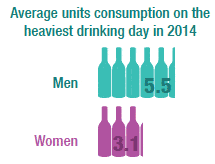 The survey findings showed that the average unit consumption on the heaviest drinking day in the past week (illustrated) declined between 2003 and 2014 (from 6.5 to units 5.5 units for men, and from 3.6 to 3.1 units for women, respectively), although consumption has not changed significantly since 2011. Average weekly alcohol consumption also declined from 19.8 units a week for men and 9.0 units for women in 2003, to 13.6 and 7.4, respectively, in 2014.
The survey findings showed that the average unit consumption on the heaviest drinking day in the past week (illustrated) declined between 2003 and 2014 (from 6.5 to units 5.5 units for men, and from 3.6 to 3.1 units for women, respectively), although consumption has not changed significantly since 2011. Average weekly alcohol consumption also declined from 19.8 units a week for men and 9.0 units for women in 2003, to 13.6 and 7.4, respectively, in 2014.
In 2014, 41% of men drank more than the recommended 3-4 units on their heaviest drinking day of the week, a reduction from 45% in 2003. A third (33%) of women drank more than their recommended 2-3 daily units, down from 37% in 2003.
In total, 23% of men and 17% of women in 2014 were classified as hazardous / harmful drinkers (consuming more than 21 units per week for men, or more than 14 units per week for women), compared with 33% and 23%, respectively, in 2003. The data also highlighted the trend that from 2008 onwards, women in the least deprived areas have been between seven and nine percentage points more likely to drink at hazardous / harmful levels than those in the most deprived areas. Women in the least deprived areas have also consumed more units per week week in each year of the survey, than women in the most deprived areas. Patterns for men were not so clear.
Commenting on the survey findings Barbara O’Donnell, Acting Chief Executive of Alcohol Focus Scotland said: “It is encouraging that people are drinking less alcohol, less often.
“However, this overall trend masks differences in consumption and harm among different groups in our society. It’s concerning that more people in higher income households are drinking at levels which puts them at risk of cancer, cardiovascular disease and liver damage. But alcohol-related deaths are six time higher in the most deprived areas of Scotland, and twice as high among men than women.
“As a society we make it easy for people to drink to excess. Marketing campaigns convince us that alcohol is an essential part of everyday life, while the cheap prices and easy availability makes it difficult for people to exercise restraint. We need to create healthier environments which provide better safeguards from the pressures to drink.”
The Scottish Health Survey, commissioned by the Scottish Government, provides a detailed picture of the nation’s health and the drinking habits of Scots. 4,659 adults and 1,668 children were surveyed in 2014 for this edition
Commission launches consultation over alcohol excise directive
Lawmakers seek public opinion on tax rules for alcoholic beverages
The European Commission has launched a three-month consultation as part of an evaluation of the alcohol structures Directive (92/83/EEC), under the recently adopted Better Regulation Framework.
Areas under review include the added value of European Union (EU) intervention in the regulatory domain and the effectiveness of the existing framework, with a view to simplifying legislation to reduce regulatory costs and protect consumers.
The views collected will help the Commission to assess if rules on excise duty should be changed in order reduce tax fraud and the sale of counterfeit alcohol, whether small producers of alcohol could benefit from changes, as well as whether consumers are properly informed about what they are drinking.
The EU needs to change the structure of excise duties in the EU directive to ensure that all types of alcohol beverage can be taxed in relation to the volume of alcohol they contain. Current excise duties vary for different alcoholic products, therefore duty does not always relate directly to the amount of alcohol in the product.
Also, an increase in the duty levied does not necessarily translate into a price increase, as retailers or producers may absorb the cost, so pricing becomes a vital part of an effective policy mix to tackle harmful and hazardous alcohol consumption.
The recent trend towards more off-trade alcohol consumption, which tends to be cheaper than alcohol sold on-trade, ought to be addressed, so a restructured excise tax directive can allow a higher rate of excise duty to be applied to alcohol sold in the off-trade and encourage a shift in consumption of lower strength products.
The consultation closes on 27 November 2015. Please follow the link for further information: http://ec.europa.eu/taxation_customs/common/consultations/tax/2015_alcohol_en.htm
Inquiry launched into the impact of alcohol on Emergency Services
Adapted from Alcohol Concern press release
The All Party Parliamentary Group on Alcohol Harm has launched an Inquiry into the ‘Impact of alcohol on the Emergency Services’.
The inquiry will examine the way in which alcohol-related incidents and injuries place a strain on emergency services in the UK and how this impacts our emergency workers and their ability to carry out their jobs.
Alcohol-related harm costs the NHS £3 billion per year and places a huge amount of pressure on our emergency services, particularly at the weekends. APPG Chair Fiona Bruce MP, and officers welcome the opportunity to hear from emergency workers, professionals and stakeholders to learn about key front-line issues and how they relate to alcohol.
Fiona Bruce said: “The costs of alcohol harm to the UK are huge, not only in terms on lives lost but also through the significant impact on society. The strain that is placed on our emergency services is enormous and I encourage the public, emergency workers and interested bodies to submit evidence.
“A central objective of the inquiry will be to build a clear picture of the time and resources that alcohol-related harm has across the Emergency Services. The Inquiry will also be holding oral evidence sessions in Parliament in October, where we have invited representatives from the Emergency Services to speak.”
The deadline for written evidence is on Monday 26th October at 5pm (submissions should be sent to appg@alcoholconcern.org.uk). Following the collation of written and oral evidence, a report will be published that highlights the findings from the inquiry.
The Institute of Alcohol Studies will publish a report looking into alcohol’s impact on the emergency services in due course, and Director Katherine Brown will be giving oral evidence to the inquiry at the parliamentary session on 26 October 2015.
Return of the social responsibility levy for Scotland?
Off-licences dominate alcohol sales; concerns raised over Scots’ drinking patterns
The Scottish Government is considering resurrecting its “social responsibility” tax on alcohol retailers as more Scots abandon pubs in favour of off licences.
Off licences now account for nearly three-quarters of alcohol sales in Scotland, compared with less than half 20 years ago, according to figures revealed by former justice secretary Kenny MacAskill at Holyrood.
He said: “Given the significant shifts in drinking patterns from the on to the off trade, with 72% now provided by the off licence trade as opposed to 49% in 1994, will the Scottish Government ensure that actions target where the major source of the problem of abuse of alcohol lies?”
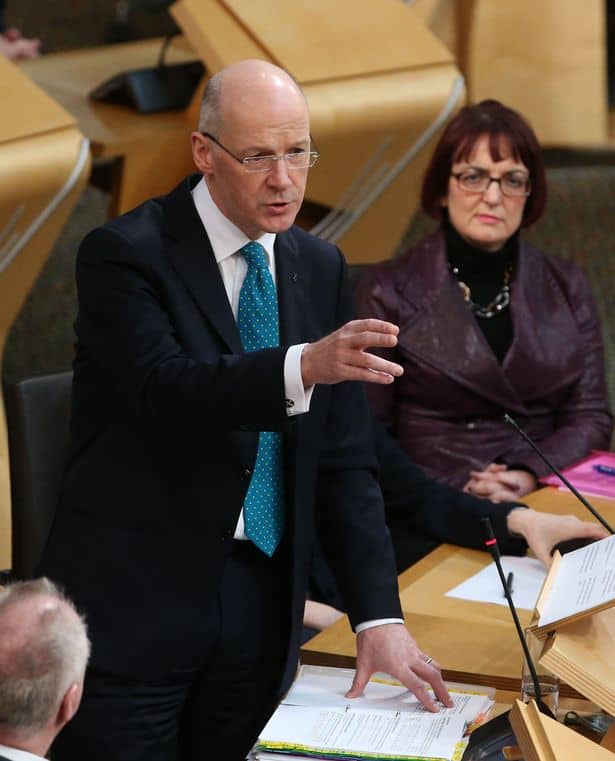 Deputy First Minister John Swinney (pictured) said the evidence Mr MacAskill has provided is “significant”.
Deputy First Minister John Swinney (pictured) said the evidence Mr MacAskill has provided is “significant”.
He added: “The Scottish Government position has always been that we will not introduce the social responsibility levy during the lifetime of the public health supplement, and until the economic circumstances are correct.
“The public health subsidy has now concluded, and the Government will consider in due course if there is a case to apply a social responsibility levy for which legislative provision currently exists.
“I can assure him that evidence that he has cited today and the points that are raised as a consequence will be part of the Government’s consideration of how to take forward this issue.”
Provisions to allow the introduction of a social responsibility levy were approved in the Alcohol (Scotland) Bill 2010, which also restricted “irresponsible” drinks promotions and advertising around premises, and set a requirement for age verification.
The tax was designed to ensure retailers and licensed premises, such as nightclubs, contribute to the wider cost of their activities to the community.
However, its implementation was temporarily shelved with the introduction of the public health supplement in 2012, a short-term tax on large shops selling alcohol and tobacco which ended in 2014.
The social responsibility levy was unpopular with some business and retail groups when it was first unveiled, with the Federation of Small Businesses warning its members would be hit harder than supermarkets and nightclubs, and the Wine and Spirit Trade Association warning it would hit Scottish consumers and businesses “while doing little to address the root causes of alcohol misuse”.
UK calls on EU to support Member States in tackling alcohol harm
Government urges greater action to be taken at European level
The UK Government issued its response to the House of Lords’ report on the European Union (EU) Alcohol Strategy. The Institute of Alcohol Studies (IAS) and the European Alcohol Policy Alliance (Eurocare) welcome the Government’s commitment and detailed opinion on how to address alcohol policies at the European level.
The response states that the UK Government broadly agrees with the House of Lords’ EU Committee’s recommendations that an EU Alcohol Strategy is important. It argues that actions from the EU should complement and support Member States and not interfere with their competence on public health. Furthermore, the Government points out the need for joint work by the EU and the WHO Regional Office for Europe for shared database and application of indicators.
Some of the key points outlined in the Government’s response include:
- A commitment to support the Scottish Government’s attempt to introduce minimum unit pricing, in the face of a legal challenge by the Scotch Whisky Association
- A call for the EU tax regulations to be adjusted for wine and cider, to incentivise the production of lower strength products
- An agreement that mandatory calorie labelling on alcohol products would provide useful information to consumers
- Criticism of the European Commission for not acting on recommendations to strengthen Member State involvement in alcohol policy via the Committee for National Alcohol Policy and Action (CNAPA).
Katherine Brown, Director of IAS (UK), says: “This is a clear call for greater action from the European Commission to support Member States in protecting the health and wellbeing of their citizens. It is not acceptable that the EU Alcohol Strategy has been left to expire in the face of repeated requests from the European Parliament and Member States. We hope this response from the UK Government will encourage the Commission to move forward in developing a new alcohol strategy as a matter of urgency.”
Mariann Skar, Secretary General of the European Alcohol Policy Alliance, says: “The United Kingdom has produced an impressive analysis from the House of Lords which has led to explicit support from the UK Government for addressing alcohol policies at the European level. We welcome these opinions, and fully support the need to address the EU added value to the policies addressed.”
National rise in violent crime at pubs
Adapted from The Morning Advertiser (PMA)
Freedom of Information (FOI) requests sent to police forces across Great Britain found that more than two thirds of areas had experienced a rise in violent crime in pubs in 2014, with the trend set to continue in some places this year.
Offences reported include murder, wounding/GBH, assault with injury, common assault, violence with an offensive weapon, harassment and other cases of violence.
In total 22 of the 31 national forces which responded to the FOI request recorded an increase in violent crime at pubs last year: London, West Yorkshire, South Yorkshire, Cambridgeshire, Cumbria, Lincolnshire, Essex, Norfolk, Powys, Nottinghamshire, Hertfordshire, Cleveland, Northamptonshire, Avon and Somerset, Greater Manchester, Merseyside, North Yorkshire, Bedfordshire, Northumbria, Sussex, North Wales and Northern Ireland. Significant year-on-year increases were seen comparing 2013 to 2014 in Merseyside, Norfolk, Northamptonshire, Sussex and South Yorkshire.
Typical figures came from Greater Manchester Police, where violent crimes rose from 1,379 reported in 2013, to 1,695 in 2014. Already 1,085 incidents have been recorded for the first half of 2015.
Inspector Phil Spurgeon from the City Centre Neighbourhood Policing Team told the PMA the rise could be down to a change in the way crime is recorded. He said the force had cracked down on violence, ensuring all calls are recorded as crimes faster than used to be the case — aiming to improve data gathering.
“This means that although we aren’t seeing an increase in calls about violence, we are seeing a higher percentage of those calls being converted to crimes and, therefore, affecting the figures,” he added.
Sergeant Kim Enderby, licensing manager at Lincolnshire Police, told the PMA about tactics that are used to try to reduce the rates.
“Following an incident we might, for example, visit a premises and suggest the introduction of polycarbonate to replace glass, a more robust search policy or a reduction of opening hours,” he said.
“If a licensee fails to make reasonable changes, or continues to break the terms of their licence resulting in repeated incidents of violence, we will take enforcement action. Ultimately this could result in the premises losing its alcohol licence.”
But it wasn’t bad news for the whole country — Gloucestershire has been one of the few areas to consistently see a reduction over the past five years.
Senior harm reduction adviser at Gloucestershire Constabulary David McFarlane said good relationships with operators had driven incidents down.
“This has resulted in venues being encouraged to report incidents so that an accurate picture, if formed, can be acted upon.”
Gloucester and Stroud uses a red and yellow banning scheme, where perpetrators are given a warning before being barred from all venues.
“This has led to a structured and consistent way of dealing with troublemakers,” he said.
Link between alcohol and poor health outcomes among world’s poorest
Global study finds gap in fortunes of drinkers from higher and lower income countries
According to The Lancet, a large study conducted by a team of researchers from several countries has highlighted the differences the health outcomes of individuals who consume alcohol in wealthy countries compared with those from poorer countries.
The prospective cohort study followed the progress of 114,970 adults aged 35-70 years from 12 countries over a three to six-year period who qualified for the Prospective Urban Rural Epidemiological (PURE) cohort study. They were categorised by four income classes: 1) High-income countries (n=12,904; 11%) represented by Sweden and Canada; 2) Upper middle-income countries (n=24,408; 21%) by Argentina, Brazil, Chile, Poland, South Africa and Turkey; 3) Lower middle-income countries (n=48,845; 43%) by China and Columbia; and 4) Low-income countries (n=28,813; 5%) by India and Zimbabwe.
Weekly alcohol consumption was measured for the study. Low intake was defined as up to seven drinks per week (14-21 UK units), moderate as seven to 14 drinks for women (14-35 UK units) and seven to 21 for men (21-50 UK units), and high as more than 14 drinks for women (35+ UK units) and 21 for men (50+ UK units).
Researchers sought associations between alcohol consumption several health outcomes, including: mortality, cardiovascular disease, heart attacks, strokes, alcohol-related cancer, injury, and admission to hospital.
Compared with those who never drank, the study identified a 16% risk reduction for the composite outcome for current drinkers in high-income countries and upper middle-income countries, but a 7% increase in risk for those lower middle-income and low-income countries.
High alcohol intake was associated with a 31% increase in mortality. The researchers also discovered that those who reported drinking at the time of follow-up (36,030 respondents) had a 24% reduced risk of suffering heart attacks compared with non-drinkers. But there was a 51% raised risk of alcohol-related cancers and a 29% raised risk of suffering injury from drinking.
Lead researcher Dr Andrew Smyth, from McMaster University in Canada, said: “Our data support the call to increase global awareness of the importance of harmful use of alcohol and the need to further identify and target the modifiable determinants of harmful alcohol use.”
Alcohol-related deaths in Northern Ireland hit poorest hardest
New dataset also confirms middle-aged drinkers worst off over last decade
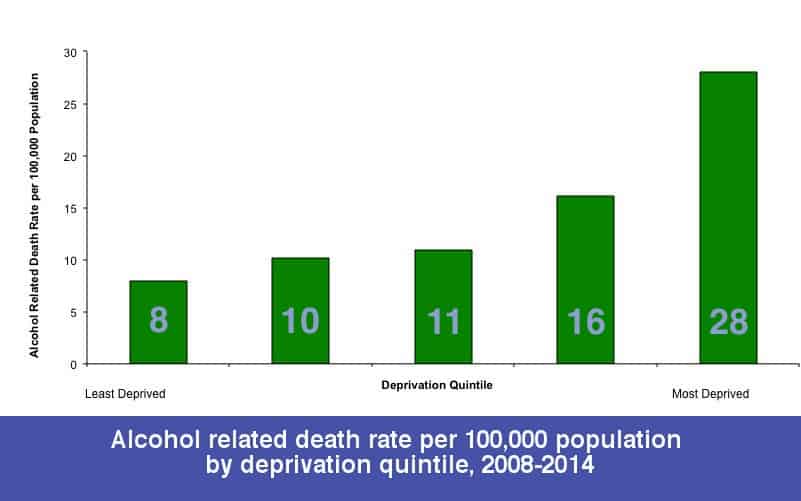
The Northern Ireland Statistics and Research Agency’s (NISRA) latest release on alcohol-related deaths shows that middle-aged people and those on low incomes are most likely to die from alcohol-related causes in Northern Ireland.
According to Alcohol Related Deaths Registered in Northern Ireland 2004-2014, there were 8 fewer male (now 164) and 10 more female alcohol-related deaths (now 74) in 2014 compared with the previous year. 69% of alcohol-related deaths during the period were male.
When categorised by age, 45-64 year-olds accounted for 61% of deaths during 2004-2014. The median average age during the decade period remained in the mid-fifties. The annual number of alcohol-related deaths for younger adults (25-44 year-olds) has halved since 2004, from 64 to 32.
The dataset also showed a positive correlation between alcohol-related death rates and socioeconomic status (from least to most deprived) during 2008-2014. There were 8 alcohol-related death rates per 100,000 population among the least deprived peoples in Northern Ireland, rising to 28/100,000 for the most deprived (illustrated).
Australian kids exposed to “tsunami of alcohol promotion”
Over 50m instances of alcohol advertising during sports programmes
Children are being “ruthlessly subjected to a tsunami of alcohol promotion,” an eminent professor of public health, Mike Daube, said in response to Australia’s first comprehensive study examining children’s exposure to alcohol advertising during sport on television.
Researchers led by Monash University in Victoria studied alcohol advertising and audience viewing data for all Australian Football League, cricket and National Rugby League TV programmes in Australia over a year-long period, and found the cumulative audience of 26.9m children and adolescents were exposed to 51m instances of alcohol advertising. Almost half (47%) of those advertisements were broadcast between 6am and 8.30pm.
Professor Mike Daube, Director of the McCusker Centre for Action on Alcohol and Youth, said previous surveys had shown more than-two thirds of Australians wanted alcohol sponsorship phased out of sport.
“Children are being ruthlessly subjected to a tsunami of alcohol promotion” he said. “Nobody outside the alcohol lobby could defend the association of alcohol with sporting success.”
The study also found the three main sports represented 60% of all alcohol advertising in sport television, and 15% of all alcohol advertisements on Australian television.
The analysis did not include alcohol advertising placed on player uniforms or on field and stadium signage, and therefore likely underestimated actual alcohol advertising exposure, the study published in Drug and Alcohol Review found.
A co-author on the study, associate professor Kerry O’Brien, said the findings should be taken “very seriously”.
“Whatever policy decisions the regulators and ministers make, they should be based on evidence,” O’Brien said.
“There have been calls from policymakers for exactly this type of research before they act, and now we’ve delivered it.”
Alcohol industry self-regulation of advertising and marketing in Australia has come under fire recently, with a review of a spirits drink on the website of a major alcohol retailer allegedly written by a 12-year-old – who described the drink as having a “gr8 flava” – being named the worst alcohol advertisement of 2014-15 by the Alcohol Advertising Review Board (AARB).
“Had a sip on my 12th birthday, went off my head,” read the review, which has since been removed by the retailer.
Foundation for Alcohol Research and Education (FARE) chief executive Michael Thorn called on the government to establish an independent review of Australia’s broadcast and digital alcohol advertising guidelines.
The current self-regulatory alcohol advertising codes had failed to protect children and adolescents from exposure to alcohol messages, he said.
“A government-instigated review could cut through the complexity, identify and resolve those failings and recommend the introduction of an effective regulatory alcohol advertising regime,” Thorn said.
“Research shows that alcohol promotions are linked to an increase in the likelihood that young people will start to drink, and increases in the amount they are drinking.”
Welsh CMO advises mothers to “keep it simple – no alcohol, no risk”
Dr Ruth Hussey keynote speech leads ‘alcohol and pregnancy’ conference
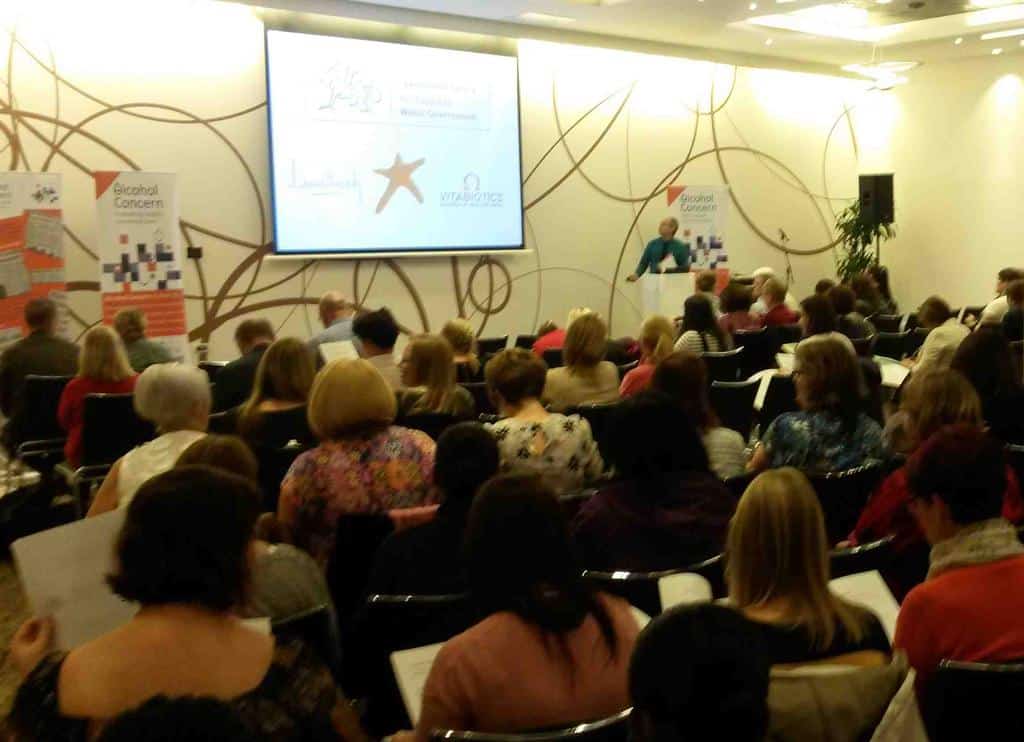 Pregnant women and those trying to conceive should not drink alcohol, Wales’ Chief Medical Officer has said.
Pregnant women and those trying to conceive should not drink alcohol, Wales’ Chief Medical Officer has said.
Dr Ruth Hussey was speaking ahead of a special conference on the issue hosted by Alcohol Concern Cymru in Cardiff, ‘Drinking for two? Alcohol and pregnancy’, which examined the potential risks of drinking alcohol while pregnant. Speakers included Dr Therese Dowswell from Liverpool University on interventions to reduce alcohol consumption in pregnancy and Dr Pam Lowe of Aston University, arguing against what some see as the over-policing of motherhood.
Latest figures estimate 39% of mothers-to-be in Wales drink alcohol although mostly only in low amounts. But Dr Hussey said in practice it was easy to underestimate the quantity in a glass and difficult to measure units of alcohol accurately. The National Institute for Health and Clinical Excellence (NICE) advises that pregnant women who choose to drink alcohol should not drink more than one to two units – equivalent to a small to medium glass of wine – once or twice a week.
Dr Hussey said: “The advice is to avoid alcohol altogether when pregnant, including when trying to conceive – so when trying for a baby or pregnant, keep it simple – no alcohol, no risk.”
Podcast
Our monthly podcast features interviews with experts from across the sector.
Gambling industry harms and parallels with the alcohol world
Will Prochaska –
Coalition to End Gambling Ads
